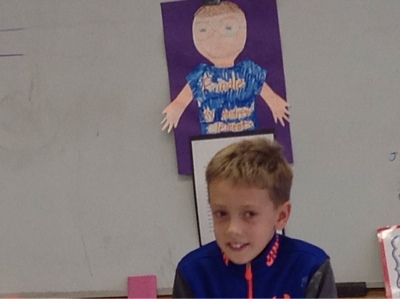I am thankful to work with students who understand the importance of GRIT.
We used Guts, Resilience, Innovation and Teamwork while creating our own version of a wetu. Wetus were the spring and summer homes of the Wampanoag tribe. We have been learning about the Wampanoag as part of our study of Massachusetts.
The task that we undertook was to try and use recyclable material and "natural resources" found in our classroom that would be comparable to the resources that the Wampanoag would have used. Instead of branches we used newspapers.
After a lot of trial and error the boys and girls figured out how to make it work. They used meter sticks to reinforce the structure. They also used cardboard to form a sort of foundation.
I think we have some future engineers and project managers in our midst.
What did you
learn by about the Wampanoag and GRIT while creating a Wetu in class?
Read on to see how students responded. to this question.
We showed GRIT by working together and sharing ideas. I learned about the Wampanoags and how they
built Wetus. It was hard building the
Wetu. We used cardboard and News Paper,
tape and meter sticks. I liked it and
want to do it again.
I learned that with GRIT anything is possible. If you don’t think it will work you should
wait and see! As long as you put your mind to it, it will work.
I learned the Wampanoag used tree bark and grass to cover
their homes. Also, they build near
streams to hunt deer and to drink and fish.
It was challenging, but I liked it.
I used GRIT when everything was falling down. I helped and preserved to make ideas and
bring it back up. It was difficult to
come up with ideas. I learned that the Wampanoag didn’t just build their wetu
instead they worked together.
I showed GRIT by being a good friend, not giving up, being
innovative, standing and trying. I
learned from the Wampanoag while building the Wetu they had to make a house or
else they bad no shelter.
I used GRIT by using teamwork to build a Wetu with my
class. I learned that it was harder than
I thought it was going to be it was really hard. It probably took them hours to build it.
When I was building the Wetu I realized it takes a lot GRIT
for the Wampanoag people. I thought that
it was very challenging to build the wetu and couldn’t imagine how hard it
would be to survive back then. When we
first started I felt like quitting but I forced myself to keep going. I also learned how important streams and
rivers were to the Wampanoag people. At first, I thought it was impossible and
didn’t know how things were going to turn out.
Do you know what GRIT is?
Well I do and I learned a lot about it today. Our class showed lots of GRIT building a nice
wetu. It took us two hours to make. Now I know how hard it was for the Wampanoag
tribe to live their life.
I used GRIT by building Wampanoag Wetu and not giving up. I
learned building a Wetu was hard. It was hard to build it but it was fun.
I loved making the wetu. I showed resilience because I didn’t
give up we all used teamwork. The
Wampanoag worked really hard too.
It was really hard and it took more than an hour and a half.
It was hard but we did it.
I showed GRIT by not giving up and by being creative. I learned that building a wetu is very hard
but fun.
We used teamwork by working together to accomplish the
wetu. I used resilience by trying and
trying to stand up the wetu. I used guts
because I wasn’t afraid to keep trying.
I used innovation by creating it because I had never done it
before.
While working on this project students demonstrated Speaking and Listening Skills.
The grade three standard is below.
1. Engage effectively in a range of collaborative discussions (one-on-one, in groups, and teacher-led) with diverse partners on grade 3 topics and texts, building on others’ ideas and expressing their own clearly.
Come to discussions prepared, having read or studied required material; explicitly draw on that preparation and other information known about the topic to explore ideas under discussion.
Follow agreed-upon rules for discussions (e.g., gaining the floor in respectful ways, listening to others with care, speaking one at a time about the topics and texts under discussion).
Ask questions to check understanding of information presented, stay on topic, and link their comments to the remarks of others.
Explain their own ideas and understanding in light of the discussion.






















































